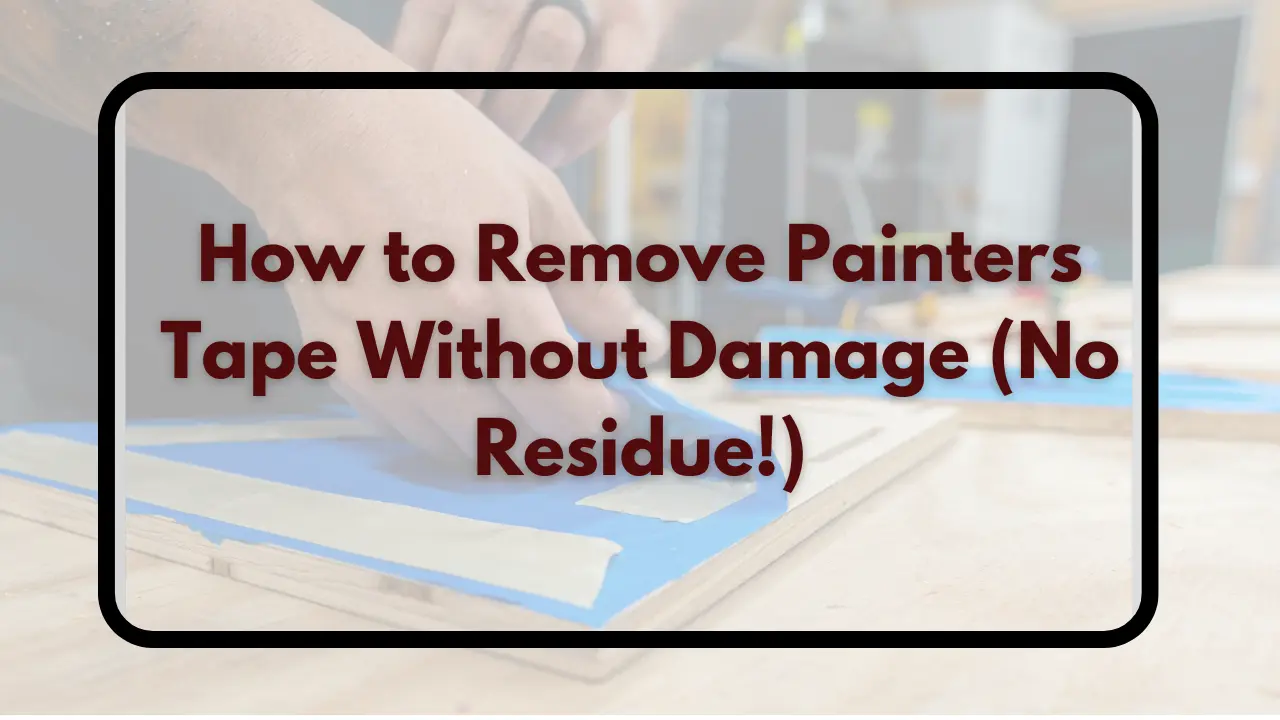How to remove painters tape without damage? Have you ever spent hours painting a room, only to peel off the tape and find chipped paint and ruined edges? It’s frustrating, especially after investing so much time and effort. Whether you’re a DIY enthusiast or a pro painter, you must master removing painter’s tape. It’s key to do so without causing damage. This guide will show you how to achieve clean, sharp lines every time.
In this article, you’ll discover practical tips for removing painters tape cleanly. You’ll learn how to do it without damaging your freshly painted surfaces. We’ll cover the best timing, tools, and methods to ensure a flawless finish. By following these steps, you’ll save time on touch-ups and enjoy the satisfaction of a job well done.
Are you ready to learn how to peel off painters tape without peeling paint? This will ensure your paint job looks professional. Let’s dive in and transform your painting projects forever!
Common Issues with Tape Removal

Common problems during tape removal include:
- Paint peeling off with the tape
- Uneven or jagged paint lines
- Adhesive residue left behind
- Damage to the surface beneath the paint
These issues can be avoided with proper techniques and timing, which we will cover in detail.
Understanding Painter’s Tape
What is Painter’s Tape?
Painter’s tape is a type of masking tape designed specifically for painting projects. It is used to protect areas from paint and create clean, straight lines. Unlike regular masking tape, painter’s tape is designed to be removed without leaving residue or damaging the surface beneath.
Types of Painter’s Tape
There are various types of painter’s tape, each suited for different surfaces and painting conditions:
- General Purpose: For most indoor painting projects.
- Delicate Surface: For use on freshly painted surfaces, wallpaper, and other delicate areas.
- Exterior: Designed to withstand outdoor conditions.
- Textured Surface: For use on textured walls and surfaces.
Uses of Painter’s Tape
Painter’s tape is versatile and can be used for:
- Creating sharp paint lines
- Protecting trim, windows, and other areas from paint
- Marking areas for cutting in
- Holding plastic sheeting in place
Preparation Before Painting
Surface Preparation
Proper surface preparation is essential for the tape to adhere correctly and prevent paint from bleeding under the tape. This includes cleaning the surface to remove dust, dirt, and grease, and ensuring it is dry and smooth.
Choosing the Right Tape
Selecting the right type of painter’s tape for your project is crucial. Consider the surface you are painting, the type of paint you are using, and the conditions (indoor vs. outdoor). Using the appropriate tape will make removal easier and reduce the risk of damage.
Proper Application Techniques
Applying painter’s tape correctly is just as important as removing it properly. Follow these steps for optimal application:
- Press Firmly: Ensure the tape is firmly pressed down to prevent paint from seeping underneath.
- Straight Lines: Use a straight edge or level to apply the tape in straight lines.
- Overlap Edges: Slightly overlap the ends of the tape to create a continuous seal.
Best Practices for Applying Painter’s Tape
Ensuring Clean Edges
To achieve clean edges, press the tape down firmly along its entire length. Use a putty knife or credit card to smooth out any bubbles or gaps.
Avoiding Common Mistakes
Common mistakes include stretching the tape too much, applying it to dirty or wet surfaces, and leaving it on for too long. Avoid these pitfalls by following proper application and removal techniques.
Tips for Different Surfaces
Different surfaces may require different approaches:
- Textured Walls: Use a tape designed for textured surfaces and press it down firmly.
- Delicate Surfaces: Use a low-tack tape and remove it gently.
- Curved Surfaces: Use flexible tape and apply it slowly, pressing down as you go.
Optimal Timing for Removing Painter’s Tape
When to Remove Painter’s Tape
The best time to remove painter’s tape is when the paint is dry to the touch but not fully cured. This usually occurs within an hour of painting, but it can vary based on the type of paint and environmental conditions.
Factors Affecting Tape Removal Time
Factors that can affect the timing include:
- Type of Paint: Oil-based paints take longer to dry than latex paints.
- Temperature and Humidity: High humidity and low temperatures can extend drying times.
- Thickness of Paint: Thicker coats of paint take longer to dry.
How to Test for Readiness
To test if the paint is ready for tape removal, touch a small, inconspicuous area. If the paint is dry to the touch but still slightly tacky, it is the ideal time to remove the tape.
Tools and Materials Needed for Tape Removal
Essential Tools
- Utility Knife: For scoring the tape
- Putty Knife: For pressing down the tape and aiding in removal
- Tweezers: For removing small pieces of tape
Optional Tools for Tricky Spots
- Hair Dryer: To soften the adhesive
- Plastic Scraper: For delicate surfaces
- Adhesive Remover: For removing residue
Safety Equipment
- Gloves: To protect your hands
- Safety Glasses: To protect your eyes from paint chips
Step-by-Step Guide to Removing Painter’s Tape
Step 1: Scoring the Tape
Use a utility knife to score the tape along the edge of the paint line. This helps prevent the paint from peeling up with the tape.
Step 2: Peeling the Tape
Slowly peel the tape back on itself at a 45-degree angle. Pulling the tape back at this angle reduces the risk of lifting the paint.
Step 3: Cleaning Up the Edges
After removing the tape, inspect the edges for any paint bleed. Use a small brush or cotton swab to touch up any imperfections.
Troubleshooting Common Issues
- Paint Peeling: If the paint starts to peel, stop and score the tape again with a sharper knife.
- Residue: If adhesive residue is left behind, use a mild adhesive remover and a soft cloth to clean it.
Preventing Damage During Tape Removal
Techniques to Avoid Paint Peeling
- Score the Tape: Scoring the tape before removal helps separate the paint layers.
- Use Low-Tack Tape: For delicate surfaces, use a tape with a lower adhesive strength.
- Remove at the Right Time: Remove the tape when the paint is dry to the touch but not fully cured.
Handling Different Surfaces
Different surfaces require different handling:
- Drywall: Be gentle and use low-tack tape.
- Wood: Ensure the surface is properly sealed before applying tape.
- Glass: Use a utility knife to score the tape carefully.
Dealing with Multiple Paint Layers
If you have multiple layers of paint, score each layer individually to prevent peeling.
Dealing with Adhesive Residue
Why Residue Occurs
Residue can occur if the tape is left on for too long or if the adhesive is too strong for the surface. It can also happen if the tape is removed too quickly or at the wrong angle.
Effective Methods to Remove Residue
- Warm Water and Soap: For mild residue, use warm water and soap with a soft cloth.
- Adhesive Remover: For tougher residue, use a commercial adhesive remover.
- Rubbing Alcohol: Apply rubbing alcohol with a cotton swab for small areas.
Tips for Different Surfaces
- Painted Walls: Use a mild solution to avoid damaging the paint.
- Glass: Use a razor blade scraper carefully.
- Wood: Use a gentle cleaner to avoid stripping the finish.
Related Article: How to Fix Dents in Prefinished Hardwood Floor: Easy Tips
Fixing Paint Damage
Assessing the Damage
Examine the damaged area to determine the extent. Small chips can be touched up easily, while larger areas may require more extensive repairs.
Quick Fixes for Small Damages
- Touch-Up Paint: Use a small brush to apply touch-up paint to minor chips.
- Sand and Repaint: Lightly sand the area and repaint for a seamless finish.
Repairing Larger Areas
For larger areas of damage:
- Sand the Area: Sand the damaged area to smooth it out.
- Apply Primer: Apply a primer to the sanded area.
- Repaint: Repaint the area, blending with the surrounding paint.
Related Article: How to Clean Plywood Subfloor (No Hassle Guide)
Expert Tips for Flawless Tape Removal
Advice from Professional Painters
- Use Quality Tape: Invest in high-quality painter’s tape for the best results.
- Proper Technique: Always pull the tape back on itself at a 45-degree angle.
- Don’t Rush: Take your time when applying and removing tape.
Common Pitfalls and How to Avoid Them
- Leaving Tape on Too Long: Remove tape within the recommended time frame.
- Improper Application: Ensure the tape is firmly pressed down to prevent bleed-through.
- Using the Wrong Tape: Choose the right tape for the surface and conditions.
Advanced Techniques
- Double Taping: For intricate designs, use a double-taping method to ensure clean lines.
- Heat Treatment: Use a hairdryer to soften adhesive for easier removal on stubborn areas.
Related article: Discover How to Paint with Painters Tape Like a Pro!
Frequently Asked Questions (FAQs)
Why Does My Painter’s Tape Tear the Paint?
Painter’s tape can tear the paint if it is removed too quickly, at the wrong angle, or if the paint is not properly adhered to the surface. Ensure you score the tape and remove it at the right time.
Can I Leave Painter’s Tape on Overnight?
It depends on the type of tape and the surface. Some tapes are designed to be left on for extended periods, while others should be removed within a few hours. Always check the manufacturer’s recommendations.
How Do I Remove Painter’s Tape from Delicate Surfaces?
Use a low-tack tape and remove it gently. If the surface is particularly delicate, use a plastic scraper or your fingernail to lift the tape slowly, and consider using a hairdryer to soften the adhesive.
Conclusion
In conclusion, removing painters tape cleanly is a process. It needs careful attention and the right methods. First, the paint must be completely dry. Then, you can try best way to remove painters tape. This means a delay of at least 24 hours. Second, you must score the edge of the tape with a sharp knife. This breaks the seal between the tape and the paint.
This step prevents the paint from peeling away with the tape. Pull the tape back on itself at a 45-degree angle to avoid paint tears. If the tape resists, use a hair dryer to soften the adhesive. Wins come from consistent effort; hasty moves bring regrettable consequences.
Follow these steps. They will let you achieve a clean, professional finish for your painting projects. For more home improvement tips, share this post on social media!




